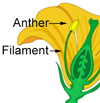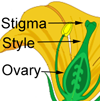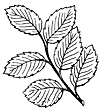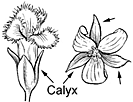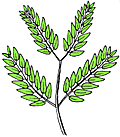Koa
Acacia koa
Pea family (Fabaceae)
Native species ()
Koa, the largest native tree and second most common, is well known. This large to very large tree becomes 100 ft (30 ) tall and 5 ft (1.5 ) or more in trunk diameter but may be only half that size. Trunk straight and tall or becoming crooked and branched; spreading, rounded to dark green. Bark light gray, smooth on small trunks, becoming very rough, thick, and deeply furrowed, scaly and shaggy. Twigs brown, becoming hairless. Mimosa subfamily (Mimosoideae).
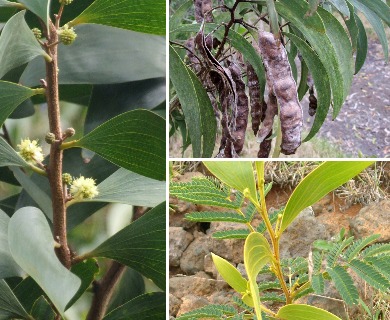
©2002-2013 J. B. Friday
Flower clusters of light yellow balls (heads) 3⁄8 inch (1 ) in diameter, one or few on slender stalks about 1⁄2 inch (13 ) long at leaf base. Flowers tiny, numerous, stalkless in balls, nearly 1⁄4 inch (6 ) long, consisting of cup-shaped five narrow petals slightly united at base, many spreading threadlike separate ending in dot and narrow with threadlike Flowering mostly in late winter and early spring.
(pods) are broad, flat, 3–6 inches (7.5–15 ) long, 5⁄8–1 inch (1.5–2.5 ) wide, brown, mostly not splitting open. Seeds are several, beanlike, 5⁄16 inch (8 ) long, oblong, flattened, straight, dark brown or blackish, slightly shiny.
Koa is an excellent cabinet wood of reddish brown color that is often highly figured. It is moderately heavy wood ( gr. 0.55) identical in weight and strength properties with black walnut (Skolmen 1968). This stable wood works and seasons well and takes a high polish. It is not resistant to decay and is quite susceptible to drywood termites.
The wood is used for furniture, cabinet work, carved bowls and turnery, gunstocks, and veneer; formerly for construction and surfboards. Many large offices as well as homes in Hawaii have paneling and furniture of koa. It is Hawaii’s best known wood. Native Hawaiians had many uses, such as house timbers, carved dugout canoes, and paddles. Koa canoes are prized for competitive paddling by outrigger canoe clubs today and logs suitable for making them are extremely scarce and costly. The bark served in tanning.
Koa is widely distributed in both dry and rain forests at 600–7000 ft (183–2134 ) altitude. Koa forests are an important habitat for rare birds. This species may be seen on all the larger islands, near Kokee on Kauai, along Likelike and Nuuanu Pali Highways on Oahu, the Hana Road near Keanae, Maui, and Hawaii Volcanoes National Park in Hawaii. There are 2.5 million cu ft (0.7 million cu ) of sawtimber in Hawaii. Only Hawaii and Kauai have tall straight-stemmed koa suitable for lumber. The trees on other islands have short crooked stems. Trees on the Island of Hawaii growing in closed forest at 4,000–6000 ft (1219–1829 ) are by far the largest.
Special areas
Waimea, Arboretum, Tantalus, Haleakala, City, Volcanoes, Kipuka Puaulu
Former champion
Height 140 ft (42.7 ), c.b.h. above bulge, 37.3 ft (11.4 ), spread 148 ft (45.1 ). District of Ka’u, Hawaii (1969). This giant was probably the largest native tree in Hawaii, the tallest as well as greatest in trunk circumference. Unfortunately, it split in two from the groundline in the late 1970s and is now quite small. A new champion has not been selected.
Range
Known only from Hawaiian Islands
A few botanical varieties have been named from different islands, distinguished by the shape of the “leaves.” Kauai koa (Acacia kauaiensis Hillebr.) is a closely related species to Kauai and common at Kokee. This large tree is easily recognized by the flower clusters of many light yellow balls (heads) at ends of twigs). Koaia (Acacia koaia Hillebr., another closely related species, is to dry areas of Molokai, Maui, and Hawaii is now rare and considered endangered. It is distinguished by seeds that lie parallel rather than perpendicular to the pod axis. Wood is heavier, harder, and more finely textured than koa.
